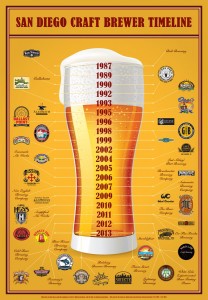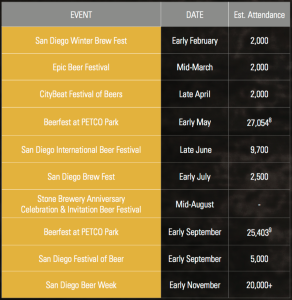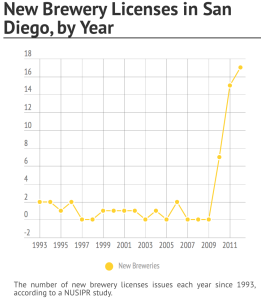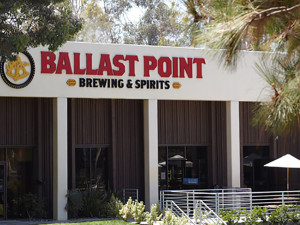Beer, it’s everywhere— from the your local pub, favorite football stadium, it’s even in your home. So what kind of economic impact does beer make in the United States and the craft brewery capital of San Diego? In 2014, small and craft breweries contributed $55.7 billion to the U.S. economy and supported over 424,000 jobs with 115,000 of those directly at breweries or brewpubs. With all this money in craft beer, it’s easy to see why in 2014 the 120 breweries in San Diego generated a local economic impact from wages, revenue and profits of $600 million. San Diego is the “craft brew capital of America” because of the support it has from local government and the strong San Diego Brewer’s Guild, which has allowed the industry to grow and create more local breweries and tourism.
San Diego’s craft brewery scene started in the 80s when California legislation was passed to legalize the brewpub. It also made commercial production and sale of beer in restaurants and home brewing legal, giving beer enthusiasts the chance to capitalize on their hobby. After California made this leap, home brewers started swapping recipes, experimenting and built the framework for the production for beer in San Diego that exists today. In fact, the story of two best friends who formed the Karl Strauss Brewing Company is one and the same.
After Prohibition, large breweries such as Budweisser dominated the market but Chris Cramer and Matt Rattner were determined to change this after a trip to Australia inspired them to open a brewpub of their own. On February 2, 1989, Karl Strauss Brewing Company opened their doors in Downtown San Diego and kick-started the craft brew revolution. Soon, their brewery grew and inspired some of their employees to open their own breweries that compose the local craft beer culture in the San Diego community today. According to the founder of Karl Strauss, Chris Kramer, “One of the reasons why San Diego has become such a mecca for craft beer is we started off with a group of individuals who were friends and collaborative rivals.” This is still true today and is the reason why San Diego’s craft brewery scene is so vibrant. Renowned breweries such as Pizza Port and Ballast Point were both started by former employees of Karl Strauss. The small craft brew circle that started at Karl Strauss and promoted the art of beer making is one of the reasons why San Diego craft brewing is successful today.
sandiegohistory.org
The idea of “family” may have started with Cramer and Rattner in 1989 but it’s the San Diego Brewer’s Guild that allowed the craft brew industry to continue to grow in San Diego. Founded in 1997, the guild was created with two goals: to promote San Diego’s brews and to create an open line of communication between brewers. Craft powerhouses like AleSmith Pizza Port, Stone Brewery, Green Flash and Karl Strauss are all members of this coalition making it easier for brewers to unite within San Diego. In addition, the guild has over 134 affiliate members that are firms, corporations and people who manufacture/sell products used in home or commercial brewing. Each sector of the guild promotes their mission to, “promote… locally brewed beer through education and participation in community events.” The SDBG also has a robust calendar online of events that occurs almost daily from “yoga and beer” to “rare beer breakfast.” In fact, beer is so imbedded in the culture that the Mayor of San Diego declared June as Craft Beer Month in 2011. Because of this, every year multiple breweries host a series of events including the San Diego International Beer Festival and meet frequently to educate the community about the benefits of craft beer.
Breweries are vital to the tourism sector of San Diego because is not seasonal, it occurs year-round with a full calendar of events. Many breweries offer facility tours and tastings in addition to their taprooms where people can become educated on the beer making process year-round. Many of the larger beer events also occur in San Diego’s off-season for tourism in autumn and spring, which can be seen below. The most notable event is San Diego Beer Week in November hosted by the San Diego Brewer’s Guild. Breweries are also packed at peak tourism season in summer when their seasonal, summer session ales become available and Craft Beer Month in June.
NUS Institute
The San Diego Brewer’s Guild hosts the most popular beer event, San Diego Beer Week, which has allowed the growth of the industry, education of beer enthusiasts and positively impacted San Diego hospitality industry. According to the San Diego Tourism & Marketing District (SDTMD), in 2009 San Diego Beer Week booked 1,000 hotel rooms and generated $115,500 in revenue when they only invested $22,320 in the event. Compare this to four years later in 2013 where the same festival generated a total of $789,794 and booked 5,943 hotel rooms with an initial investment of $68,936 with SDTMD—that’s almost seven times the original revenue made. This growth is due to the “boom” of the industry in 2010, where nearly 40 breweries opened between 2009 and 2011. Beer Week has a wide variety of events that are either put on by independent breweries or the guild themselves culminating in the San Diego Brewers Guild Festival. Attendees can also go to “Beer College” and receive an extension-brewing certificate from UC San Diego or a professional certificate in the business of craft beer from San Diego State University. Beer Week enhances the mission of the guild to promote local beer through education and participation in community events while also making an impact on the tourism sector of San Diego.
voiceofsandiego.org
In San Diego, breweries are a fast growing business sector because of the tourism and tax revenue it generates. The expansion of breweries in San Diego translates to a boom of jobs and contributions to the local economy through these jobs, revenue and taxes to the City of San Diego. In 2011, the direct economic impact in San Diego County was $299.5 million generated by breweries and brewpubs, this is more than one and a half times the economic impact of Comic-Con International San Diego. In this same year, the industry made $660.8 million in sales and created 2,796 jobs. However, in 2014, the craft brew economic sector had an economic value doubled in the region of $600 million. This figure is generated based on San Diego’s 120 local breweries and their revenue, profits, wages and jobs the industry produces. To give you an idea of the level impact this is, the economic impact Super Bowl XLIX had on the state of Arizona was $500 million. The money generated by this industry goes to the local government from retail, real estate and property, income and sales taxes. In fact, California breweries paid around $850 million in local, state and federal taxes in 2012.
The local government has created policies that allow the industry to flourish in San Diego and keep breweries within their county. In 2013, they created the Microbrewery Ordinance, which changed the municipal code to allow beer manufactures to operate full-service restaurants within a brewery as an accessory of use if this environment did not exceed more than 25 percent of the total floor area. Thus, breweries can be permitted as restaurants in all commercial and some industrial zones. Thanks to the government, these restaurant add-ons to breweries can create more income and jobs to further enhance the local economy. Stone’s World Bistro and Garden in Escondido is a prime example of this, where their restaurant is the third most visited attraction in San Diego after the San Diego Zoo and Legoland.
The city also formed the Business and Industry Incentive Program as a way to keep breweries in San Diego instead of moving to other cities. It provides businesses with flexible economic development incentives if they provide revenue and jobs that promote city taxes and encourage business development in underdeveloped parts of San Diego. If they can prove this, the government could persuade breweries through fee reimbursements to keep their businesses in San Diego. These fees, which represent city permit fees and are determined by the City Council approval, can be reimbursed in the form of property taxes and taxable property. It is because of these policies that the government allowed Ballast Point and AleSmith to expand their brewery facilities within San Diego County to Miramar. In the case of Ballast Point, the brewery wanted to move but with this deal, the city will reimburse them for the additional tax revenue they would have received from an expansion project if they chose to expand in Miramar instead. In addition, the local government would give back 50 percent of future sales tax at the expanded location until they paid back the brewery for the municipal fees they would need to pay to move their facility. This represented a $156,000 reimbursement from the City of San Diego to Ballast Point. It may seem one-sided but the City would now collect $35,000 more in taxes a year at the new location for Ballast Point after their three-year reimbursement period ends. Because of this partnership with the city, breweries have the chance to stay in San Diego, create innovative beers and communicate to a robust tourism industry.
ballastpoint.com
Craft beer is more than a delicious drink— it’s an economic factor that affects local, statewide and the national economy. In fact, craft breweries make up most of America’s beer market and saw production volume increase 16 percent from January to June in 2015. San Diego is a hub for this type of innovative beer market because the government works with the community to grow the industry and brewers are a tight-knit community that promotes the art of beer together within the San Diego Brewer’s Guild. These two factors are the reason that San Diego has its own IPA category of beer and produces more than 2,000 unique beers annually. If the local San Diego community keeps supporting the craft beer industry and the San Diego Brewer’s Guild stays true to their message, there is a chance that the beer bubble won’t bust for a while longer and small batch brewers will continue to succeed.




Leave a Reply
You must be logged in to post a comment.